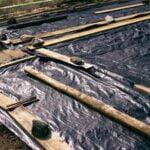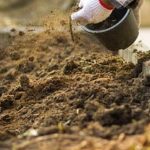The use of pressure treated lumber in vegetable gardens has become increasingly popular among gardeners and homeowners looking to construct durable and long-lasting raised garden beds. Pressure treated lumber is a type of wood that has been chemically treated to resist decay, rot, and insect damage, making it an attractive choice for outdoor construction projects.
In this article, we will explore the process and purpose of pressure treating wood, the benefits and potential risks of using pressure treated lumber in vegetable gardens, as well as safe usage guidelines and alternatives.
As more people take an interest in growing their own food at home, the demand for reliable and cost-effective materials for garden bed construction has led many to consider pressure treated lumber as a viable option. Its ability to withstand moisture, soil contact, and outdoor exposure makes it an appealing choice for those who want a low-maintenance solution for their vegetable gardens.
However, concerns about the safety of using pressure treated lumber in close proximity to edible plants have sparked a debate within the gardening community.
In this article, we will delve into the various aspects of using pressure treated lumber in vegetable gardens – from its advantages and potential drawbacks to practical tips for minimizing risks. Additionally, we will explore alternative materials that can be used to construct garden beds without compromising safety or longevity.
Whether you are a seasoned gardener or just beginning your horticultural journey, understanding the implications of using pressure treated lumber in your vegetable garden is essential for making informed decisions about your gardening practices.
What Is Pressure Treated Lumber?
Pressure treated lumber has become a popular choice for constructing vegetable garden beds, thanks to its durability and resistance to decay. But what exactly is pressure treated lumber, and how is it different from regular wood?
Pressure treated lumber is wood that has been infused with preservatives to protect it from rot, decay, and insect damage. The process involves placing the wood in a depressurized treatment vessel, where the preservative solution is forced into the wood fibers under high pressure. This helps the treatment penetrate deep into the wood, providing long-lasting protection.
The primary purpose of pressure treating wood is to extend its lifespan when used in outdoor environments, such as vegetable gardens. By improving its resistance to moisture and pests, pressure treated lumber can withstand the rigors of being constantly exposed to soil and water, making it an ideal choice for garden beds.
According to a study conducted by the University of California Cooperative Extension, pressure treated lumber containing alkaline copper quaternary (ACQ) or copper azole (CA-B) was found to be safe for use in vegetable gardens. However, it is important to note that different types of pressure treated lumber may contain different chemicals, so it’s crucial for gardeners to research and select options that are deemed safe for their specific gardening needs.
| Benefits | Details |
|---|---|
| Durability | Resistance to rot, decay, and insect damage. |
| Protection | Can withstand constant exposure to soil and water. |
Benefits of Using Pressure Treated Lumber in Vegetable Gardens
Using pressure treated lumber in vegetable gardens offers several advantages that make it a popular choice among gardeners. Here are some of the key benefits of using pressure treated lumber in garden beds:
Durability and Longevity
Pressure treated lumber is treated with chemicals to resist decay, rot, and insect infestations, making it highly durable and long-lasting. This means that garden beds constructed with pressure treated lumber are less likely to deteriorate over time, providing a stable and reliable structure for growing vegetables.
Cost-Effectiveness
Compared to other types of wood or materials used for building garden beds, pressure treated lumber is often more affordable. Its longevity also means that it can be a cost-effective investment in the long run, as it reduces the need for frequent replacements or repairs.
Low Maintenance
Because pressure treated lumber is resistant to decay and insects, it requires minimal maintenance compared to untreated wood. This makes it an attractive option for busy gardeners who want a low-maintenance solution for their vegetable gardens.
Despite these benefits, it’s important to use caution when using pressure treated lumber in vegetable gardens due to potential risks and concerns related to the chemicals used in the treatment process. By taking certain precautions and considering alternative materials, gardeners can enjoy the advantages of pressure treated lumber while minimizing any potential risks.
Potential Risks and Concerns
Pressure treated lumber has become increasingly popular in gardening, including the construction of vegetable garden beds. However, there are potential risks and concerns associated with using this type of wood in close proximity to edible plants. It’s important for gardeners to be aware of these issues and take necessary precautions to ensure the safety of their crops and their own health.
The primary concern with pressure treated lumber in vegetable gardens is the leaching of chemicals into the soil. The process of pressure treating wood involves impregnating it with preservatives such as chromated copper arsenate (CCA) to protect against decay and insect damage. Over time, these chemicals can seep into the surrounding soil, potentially contaminating the plants grown in that area. This raises red flags for many gardeners who prioritize organic or eco-friendly growing practices.
To address these risks and concerns when using pressure treated lumber in vegetable gardens, gardeners can take several steps to minimize potential harm. Firstly, lining the inside of the garden bed with a thick plastic barrier can prevent direct contact between the wood and the soil, reducing the likelihood of chemical leaching.
Additionally, opting for newer alternatives such as Alkaline Copper Quaternary (ACQ) treated wood or composite materials can provide a safer option for constructing garden beds while still enjoying the benefits of preserved wood.
In addition to taking precautions when using pressure treated lumber in vegetable gardens, it’s also important for gardeners to monitor their crops closely for any signs of stress or contamination. By staying informed and attentive, gardeners can make well-informed decisions about which materials are best suited for their individual gardening needs and preferences.
How to Safely Use Pressure Treated Lumber in Vegetable Gardens
Pressure treated lumber is a popular choice for constructing garden beds due to its durability and resistance to rot and decay. However, there are concerns about the potential risks it may pose to vegetable gardens. Here are some tips and guidelines for safely using pressure treated lumber in your vegetable garden:
- Choose the right type of pressure treated lumber: Look for wood that has been treated with ACQ (Alkaline Copper Quaternary) or copper azole, as these treatments are considered safer for use in vegetable gardens.
- Line the interior of the garden bed: To create a barrier between the soil and the pressure treated lumber, consider lining the interior of the garden bed with heavy-duty plastic sheeting. This will prevent direct contact between the wood and the soil where vegetables are growing.
- Avoid using pressure treated lumber for edible plants: If you have concerns about potential leaching of chemicals from the wood into the soil, reserve its use for ornamental plants or non-edible landscaping features within your garden.
When using pressure treated lumber in your vegetable garden, it’s important to prioritize safety measures to minimize any potential risks associated with its use. By following these guidelines, you can make informed decisions for incorporating pressure treated lumber into your garden beds while ensuring the health and well-being of your vegetables.
In addition, regularly monitor your vegetable plants for any signs of stress or abnormal growth that may be linked to the use of pressure treated lumber. By staying attentive and proactive in caring for your vegetable garden, you can address any issues promptly and maintain a thriving growing environment.
Alternatives to Pressure Treated Lumber
Since pressure treated lumber has been associated with potential risks and concerns when used in vegetable gardens, many gardeners are seeking alternative materials for constructing their garden beds. Fortunately, there are several options available that can provide a safe and effective alternative to pressure treated lumber.
One popular choice for constructing garden beds is cedar wood. Cedar is naturally resistant to rot and insects, making it an excellent option for organic gardening. Its natural oils act as preservatives, eliminating the need for chemical treatments. While cedar may be more expensive than pressure treated lumber initially, its durability and longevity make it a cost-effective choice in the long run.
Another alternative material for constructing garden beds is composite lumber. Made from a combination of wood fibers and recycled plastic, composite lumber offers the look of wood without the maintenance requirements. It is durable, resistant to rot and decay, and does not contain harmful chemicals like pressure treated lumber. Additionally, composite lumber is available in a variety of colors, allowing gardeners to customize the appearance of their garden beds.
For those looking for a budget-friendly alternative to pressure treated lumber, consider using untreated pine or fir. While these types of wood may not have the same level of resistance to decay as cedar or composite lumber, they can still be used effectively in vegetable gardens with proper maintenance and care.
| Alternative Material | Advantages |
|---|---|
| Cedar wood | Naturally resistant to rot and insects |
| Composite lumber | Durable, resistant to rot and decay, made from recycled materials |
| Untreated pine or fir | Budget-friendly option with proper maintenance |
Case Studies and Success Stories
High-Yield Harvests
Several gardeners have reported bountiful harvests from their vegetable gardens built with pressure treated lumber. The treated wood provides a sturdy and durable structure for the garden beds, allowing for deep root growth and ample space for plants to flourish. With pressure treated lumber, the risk of rot and decay is minimized, resulting in longer-lasting garden beds that can support healthy and productive crops.
Longevity and Low Maintenance
One of the key advantages of using pressure treated lumber in vegetable gardens is its longevity and low maintenance requirements. Many gardeners have shared their positive experiences with this type of wood, highlighting that it requires minimal upkeep over time. The treated wood is resistant to insects, decay, and moisture damage, reducing the need for frequent replacements or repairs. This added durability ensures that the vegetable gardens can thrive for many seasons without significant deterioration.
Environmental Impact
In addition to the practical benefits, some gardeners have also noted the environmental advantages of using pressure treated lumber in their vegetable gardens. By choosing a long-lasting material like pressure treated wood, they are reducing the overall consumption of resources needed for garden bed construction.
This sustainable approach aligns with eco-friendly gardening practices and promotes the efficient use of materials. Additionally, when properly maintained and managed, pressure treated lumber can contribute to the creation of thriving and sustainable vegetable gardens for years to come.
Conclusion
In conclusion, pressure treated lumber can be a useful and practical material for constructing vegetable gardens, as it offers durability and resistance to decay. However, it is important for gardeners to be aware of the potential risks and concerns associated with using this type of wood in their gardening projects.
By understanding the process and purpose of pressure treating wood, as well as following safety guidelines and considering alternative materials, gardeners can make informed decisions about whether or not to use pressure treated lumber in their own gardens.
While the benefits of using pressure treated lumber in vegetable gardens are evident, including its longevity and low maintenance requirements, it is crucial to recognize the controversy surrounding its potential impact on soil and plant health. Gardeners should take precautions such as using a plastic lining or other barrier between the wood and the soil to minimize any leaching of chemicals into the garden beds. Additionally, regular soil testing can help monitor any potential accumulation of harmful substances.
Ultimately, each gardener must weigh the advantages and disadvantages of using pressure treated lumber in their vegetable gardens before making a decision. Considering alternatives such as naturally resistant woods, composite materials, or untreated lumber may also be beneficial for those who have concerns about the safety of pressure treated wood. By being informed about these options and taking necessary precautions, gardeners can create healthy and thriving vegetable gardens while using pressure treated lumber responsibly.
Frequently Asked Questions
Is It OK to Use Pressure-Treated Wood in a Vegetable Garden?
Using pressure-treated wood in a vegetable garden is a topic of debate. Pressure-treated wood contains chemicals that can potentially leach into the soil and be absorbed by plants. It’s best to avoid using it in direct contact with soil for growing vegetables.
Is Home Depot Pressure-Treated Wood Safe for Vegetable Gardens?
While Home Depot offers pressure-treated wood, it’s important to note that this type of wood is typically treated with chemicals like chromated copper arsenate (CCA), which can be harmful if it comes into contact with food crops. Therefore, it’s not considered safe for use in vegetable gardens.
What Wood Should Not Be Used in a Raised Garden Bed?
Certain types of wood, such as old railway sleepers, treated plywood, or any wood that has been painted, stained or treated with toxic chemicals should be avoided in raised garden beds. These could potentially contaminate the soil and harm the plants being grown there. Opt for untreated natural wood like cedar or redwood instead.

If you’re looking to get into vegetable gardening, or are just looking for some tips on how to make your current garden better, then you’ve come to the right place! My name is Ethel and I have been gardening for years. In this blog, I’m going to share with you some of my best tips on how to create a successful vegetable garden.





